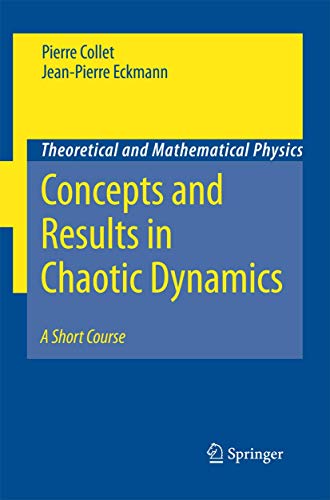Verwandte Artikel zu Concepts and Results in Chaotic Dynamics: A Short Course...
Concepts and Results in Chaotic Dynamics: A Short Course (Theoretical and Mathematical Physics) - Softcover

Inhaltsangabe
This book is devoted to the subject commonly called Chaotic Dynamics, namely the study of complicated behavior in time of maps and ?ows, called dynamical systems. The theory of chaotic dynamics has a deep impact on our understanding of - ture, and we sketch here our view on this question. The strength of this theory comes from its generality, in that it is not limited to a particular equation or scienti?c - main. It should be viewed as a conceptual framework with which one can capture properties of systems with complicated behavior. Obviously, such a general fra- work cannot describe a system down to its most intricate details, but it is a useful and important guideline on how a certain kind of complex systems may be understood and analyzed. The theory is based on a description of idealized systems, such as “hyperbolic” systems. The systems to which the theory applies should be similar to these idealized systems. They should correspond to a ?xed evolution equation, which, however, need to be neither modeled nor explicitly known in detail. Experimentally, this means that the conditions under which the experiment is performed should be as constant as possible. The same condition applies to analysis of data, which, say, come from the evolution of glaciations: One cannot apply “chaos theory” to systems under varying external conditions, but only to systems which have some self-generated chaos under ?xed external conditions.
Die Inhaltsangabe kann sich auf eine andere Ausgabe dieses Titels beziehen.
Von der hinteren Coverseite
The study of dynamical systems is a well established field. The authors have written this book in an attempt to provide a panorama of several aspects, that are of interest to mathematicians and physicists alike. The book collects the material of several courses at the graduate level given by the authors. Thus, the exposition avoids detailed proofs in exchange for numerous illustrations and examples, while still maintaining sufficient precision. Apart from common subjects in this field, a lot of attention is given to questions of physical measurement and stochastic properties of chaotic dynamical systems.
„Über diesen Titel“ kann sich auf eine andere Ausgabe dieses Titels beziehen.
Neu kaufen
Diesen Artikel anzeigenEUR 4,78 für den Versand von Vereinigtes Königreich nach USA
Versandziele, Kosten & DauerSuchergebnisse für Concepts and Results in Chaotic Dynamics: A Short Course...
Concepts and Results in Chaotic Dynamics: A Short Course
Anbieter: PBShop.store UK, Fairford, GLOS, Vereinigtes Königreich
PAP. Zustand: New. New Book. Shipped from UK. Established seller since 2000. Artikel-Nr. DB-9783642421150
Anzahl: 1 verfügbar
Concepts and Results in Chaotic Dynamics: A Short Course (Theoretical and Mathematical Physics)
Anbieter: Ria Christie Collections, Uxbridge, Vereinigtes Königreich
Zustand: New. In. Artikel-Nr. ria9783642421150_new
Anzahl: Mehr als 20 verfügbar
Concepts and Results in Chaotic Dynamics: A Short Course
Anbieter: Kennys Bookstore, Olney, MD, USA
Zustand: New. Series: Theoretical and Mathematical Physics. Num Pages: 244 pages, 1 black & white tables, biography. BIC Classification: PBWR; PHU. Category: (G) General (US: Trade). Dimension: 235 x 155 x 13. Weight in Grams: 385. . 2014. Paperback. . . . . Books ship from the US and Ireland. Artikel-Nr. V9783642421150
Anzahl: 15 verfügbar
Concepts and Results in Chaotic Dynamics: A Short Course
Anbieter: AHA-BUCH GmbH, Einbeck, Deutschland
Taschenbuch. Zustand: Neu. Druck auf Anfrage Neuware - Printed after ordering - This book is devoted to the subject commonly called Chaotic Dynamics, namely the study of complicated behavior in time of maps and ows, called dynamical systems. The theory of chaotic dynamics has a deep impact on our understanding of - ture, and we sketch here our view on this question. The strength of this theory comes from its generality, in that it is not limited to a particular equation or scienti c - main. It should be viewed as a conceptual framework with which one can capture properties of systems with complicated behavior. Obviously, such a general fra- work cannot describe a system down to its most intricate details, but it is a useful and important guideline on how a certain kind of complex systems may be understood and analyzed. The theory is based on a description of idealized systems, such as 'hyperbolic' systems. The systems to which the theory applies should be similar to these idealized systems. They should correspond to a xed evolution equation, which, however, need to be neither modeled nor explicitly known in detail. Experimentally, this means that the conditions under which the experiment is performed should be as constant as possible. The same condition applies to analysis of data, which, say, come from the evolution of glaciations: One cannot apply 'chaos theory' to systems under varying external conditions, but only to systems which have some self-generated chaos under xed external conditions. Artikel-Nr. 9783642421150
Anzahl: 1 verfügbar

